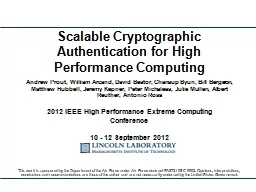PPT-Andrew Prout, William Arcand, David Bestor, Chansup Byun, Bill Bergeron, Matthew Hubbell,
Author : jane-oiler | Published Date : 2018-10-31
2012 IEEE High Performance Extreme Computing Conference 10 12 September 2012 Scalable Cryptographic Authentication for High Performance Computing This work is sponsored
Presentation Embed Code
Download Presentation
Download Presentation The PPT/PDF document "Andrew Prout, William Arcand, David Best..." is the property of its rightful owner. Permission is granted to download and print the materials on this website for personal, non-commercial use only, and to display it on your personal computer provided you do not modify the materials and that you retain all copyright notices contained in the materials. By downloading content from our website, you accept the terms of this agreement.
Andrew Prout, William Arcand, David Bestor, Chansup Byun, Bill Bergeron, Matthew Hubbell,: Transcript
Download Rules Of Document
"Andrew Prout, William Arcand, David Bestor, Chansup Byun, Bill Bergeron, Matthew Hubbell,"The content belongs to its owner. You may download and print it for personal use, without modification, and keep all copyright notices. By downloading, you agree to these terms.
Related Documents













